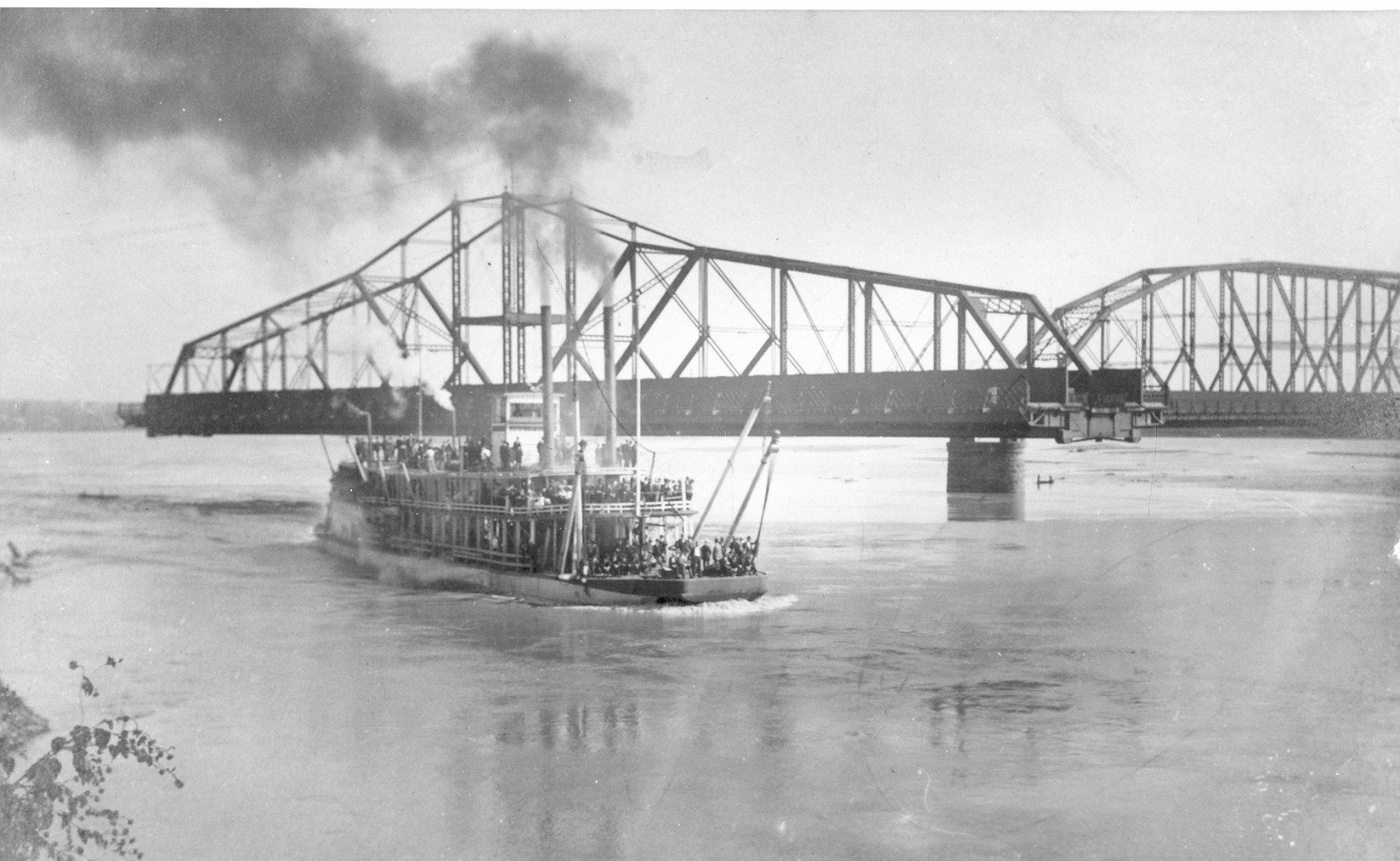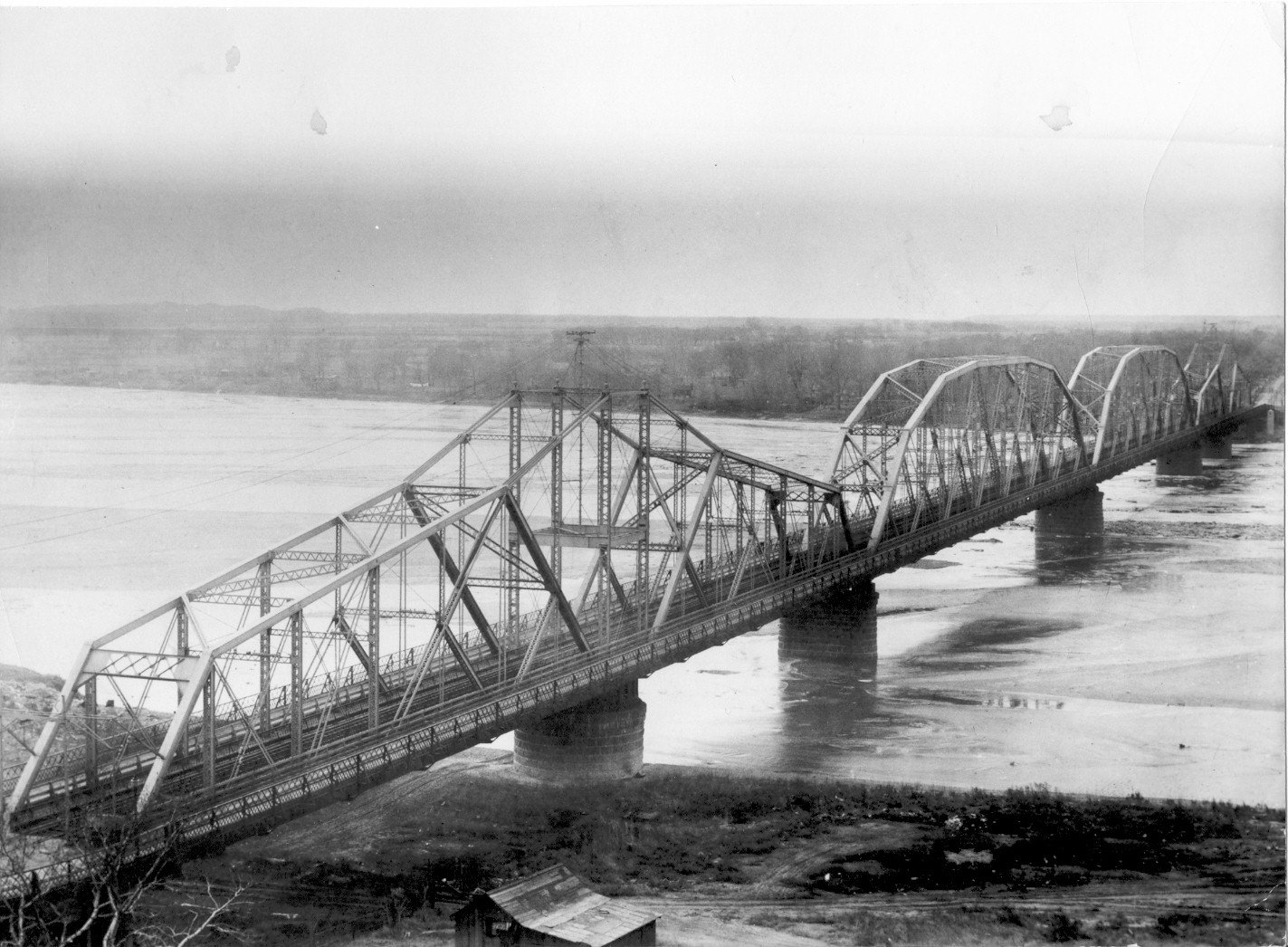Bridges
Pontoon Bridge
For the earliest Sioux City settlers, the only way to cross the Missouri River to Nebraska was to take a boat or swim. At first, a fleet of flatboats transported people and goods back and forth across the river. Next, a steamboat ferry operated by the Sioux City Land and Ferry Company provided service. That company failed to make a profit, however, and the steamboat ferry was abandoned.
The Missouri River Railroad Bridge was the first bridge linking Sioux City and Nebraska. Completed in December 1888, it was the product of sixteen years of effort by Sioux City businessmen and promoters. Originally, the plans were to make the bridge a double-decker, allowing wagons to cross on the top and trains on the bottom. That feature, however, was abandoned during the construction, and it ended up strictly a railroad bridge.
Built for the Chicago, St. Paul, Minneapolis and Omaha Railroad, the bridge was considered to be an engineering marvel. Stone piers, that were sunk 90 feet below the surface, supported its four 300-foot spans.
However, the Railroad Bridge was soon involved in controversy. The excitement was spoiled by the refusal of the railroad company to allow other railroads to use the bridge for a reasonable price. This was against the original agreement. The arguments that followed prompted support of the new combination bridge, a multipurpose bridge located closer to downtown Sioux City.
When the Railroad Bridge plans were changed to exclude wagon and pedestrian traffic, a group of enterprising Sioux City businessmen opened a pontoon bridge across the Missouri. Opened in 1889, the bridge was anchored at the foot of Pearl Street. It was really a series of boats, covered with a plank roadway. The boats were anchored with 2000-pound blocks of granite. One section was constructed so that it could swing open and allow steamboats to pass through. As crude as it was, the bridge was easier to use than the ferry.
Sioux City was excited to have at last a foot and wagon bridge across the Missouri. The bridge opened with great celebration, and it was reported that more than 10,000 people paid the five-cent toll to cross over the river.
One reason for the pontoon bridge's popularity was its connection to the Nebraska town of Covington. After the murder of Reverend Haddock, feelings were running high against the bootleggers, gamblers and saloonkeepers in Sioux City. Many of them moved across the river to Covington, where the nearest sheriff was miles away in Dakota City. At the time, prohibition was in effect in Iowa, but not in Nebraska. The Sioux City Journal noted in 1889, "The bridge may owe considerable of its patronage to the fact that it is a connecting link between prohibition and judicious license."
The pontoon bridge yielded a daily income of around $100, with a toll of five cents each way. The bridge operated from 1889 until 1896, when the new Combination Bridge opened for business.
The Combination Bridge project developed from frustration at the large tolls obtained by the railroad company operating the Missouri Railroad Bridge. Railroads were unable to expand and Sioux City leaders were concerned that the lack of an economical bridge would discourage other railroads from coming here. Donald McLean, a railroad promoter with a plan, led the bridge project. His plan was to develop a railroad from Sioux City to Utah. He convinced local businessmen, including John Peirce, that the railroad would benefit Sioux City. A bridge was part of the plan. The proposed bridge was called the Combination Bridge because it would allow for pedestrian, wagon and train traffic.
Work on the bridge began in August of 1890. McLean, however, ran into financial problems and work stopped. Arthur Garretson came to the rescue, and with his associates, he took over the project. Work began again. However, in April 1893, the world Financial Panic hit Sioux City and the bridge company became bankrupt. Work on the bridge stopped once more.
Once again, the Combination Bridge changed ownership and a new bridge company was formed of eastern capitalists and investors. One of those capitalists was F. L. Eaton, who came to Sioux City at that time and remained here to make the city his home. After investor's creditors decided that the bridge was needed in order to insure financial strength in Sioux City, and after the people of Sioux City passed a two percent tax to support the project, the work could begin again.
At last, the Combination Bridge opened on January 21, 1896. It was an engineering masterpiece. Footings, seventy-four feet deep, provided foundation for the concrete piers. Spans on both the north and south ends swung out over the river, pivoting on a single concrete pier and allowing boats to pass beneath it. Which end was used depended on the navigation of the river at that time.
In 1915, the Combination Bridge went into the hands of receivers again, and it went through many refinancing programs throughout its early years. Until 1951 the combination bridge operated as a toll bridge. Citizens rejoiced when on February 8, 1951, the bridge became a toll free bridge and the title was transferred to the Highway Commissions of Iowa and Nebraska. By this time, the Combination Bridge was primarily used for motorized and pedestrian traffic.




